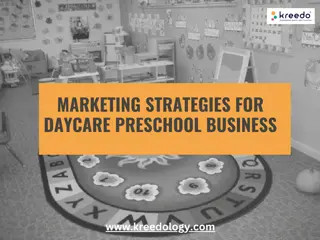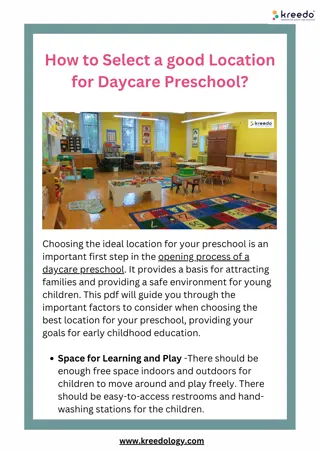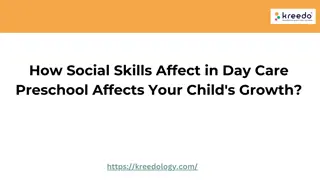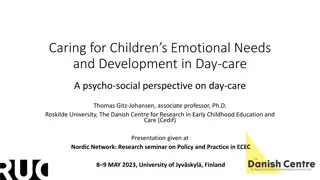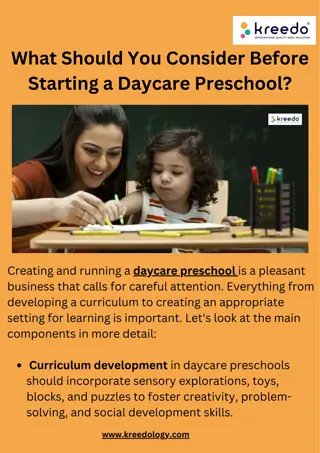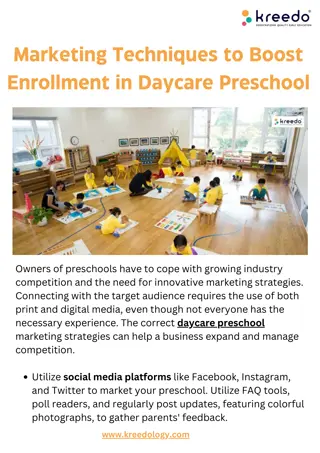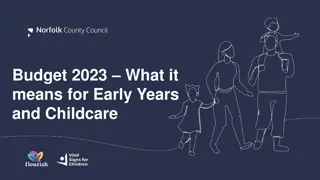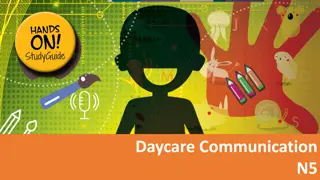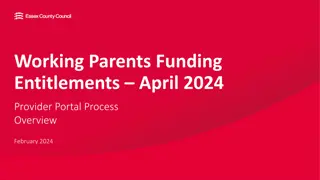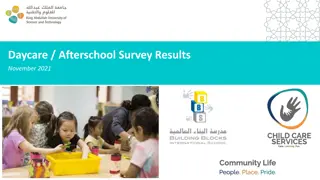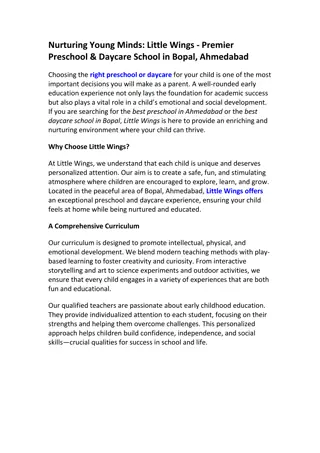Insights Into the Daycare Industry and Working Parents in the US
The daycare industry in the US is expected to grow steadily, with revenues projected to increase annually. Private pay is the primary revenue source, but employer-sponsored daycare is on the rise. The population of young children is slowly increasing, impacting the demand for childcare services. A significant percentage of mothers and fathers with young children are employed, and there is a trend towards company-sponsored childcare solutions to support working parents. Budgeting for childcare remains a challenge, especially for single-income households and millennials.
Download Presentation

Please find below an Image/Link to download the presentation.
The content on the website is provided AS IS for your information and personal use only. It may not be sold, licensed, or shared on other websites without obtaining consent from the author.If you encounter any issues during the download, it is possible that the publisher has removed the file from their server.
You are allowed to download the files provided on this website for personal or commercial use, subject to the condition that they are used lawfully. All files are the property of their respective owners.
The content on the website is provided AS IS for your information and personal use only. It may not be sold, licensed, or shared on other websites without obtaining consent from the author.
E N D
Presentation Transcript
Childs Play IBISWorld estimates 2017 daycare industry revenues were $48.9 billion, and will increase 1.9% annually to reach $52.5 billion by 2021. Private pay generates most revenues, but employer-sponsored daycare is expected to increase. IBISWorld reported there were approximately 816,343 daycare operators during 2017 and this number is projected to increase 1.2% annually through 2021. The majority of these operators are non-employing, one- person entities (babysitters). US Census Bureau information as of 2016, however, shows 75,314 establishments for child day care services (NAICS code 624410), 37% of which had 1 4 employees; 19%, 5 9; 23%, 10 19; 18%, 20 49; and 3% had 50 or more employees.
Population of Young Children Slowly Increasing The US birth rate has been decreasing since 2008, with a brief increase during 2014. During 2016, the fertility rate decreased to 60.2 births/1,000 women of childbearing age, a 3% decrease from 2016. The biggest decrease was among Hispanics, at -27%. During 2017, the US added 2,450,697 people to its population, 57.8% of whom were from net births (births minus deaths) and the remainder from immigration. As of 2030, immigration will account for more of the increase in the American population than net births, and the increase of population will slacken.
She Works Hard for a Living According to the US Department of Labor, 69.9% of mothers and 98.2% of fathers with children younger than 18 are employed. Of mothers with a child younger than 6, 63.9% work, 61.1% with a child younger than 3 and 57.3% with a child younger than 1. Married-couple families account for 67.4% of families with children younger than 18 and 25.3% are single- mother and 7.3% single-father families. According to the US Congressional Budget Office, there will be no change in the projected labor force participation rate from 2017 to 2028 for both married females with young children and unmarried females with young children.
Company-Sponsored Childcare A tight labor market has prompted many employers to add a childcare solution to retain and attract female employees. Solutions include onsite childcare, investing in childcare providers with employee priority admission and subsidies. During 2014 (the latest data), 39% of civilian workers had access to employer-sponsored childcare reimbursement accounts, and 11% to workplace- funded childcare. The largest percentage (67%) of US employers offering childcare assistance during 2017 did so with Dependent Care Assistance Plans (DCAPs) that help employees pay for childcare with pre-tax dollars.
Budgeting for Childcare During 2016, the cost of childcare for an infant was more than the affordability threshold of 7% of the median income for a 2-income family in 49 states plus the District of Columbia. Some low-income families qualify for government subsidies or tax credits. For single-income households, childcare averaged more than 40% of median income, 33% higher than the federally recommended cost. Subsidies can increase the likelihood of single mothers being employed full-time. Millennials unemployment rate is 40% higher than the national average. For those who are employed, average infant care costs are more than 27% of Millennials median income, 20% higher than the federally recommended cost.
Finding Quality Childcare in the Desert The Center for American Progress defines a childcare desert as any census tract with more than 50 children younger than 5 with either no providers or so few that there are more than three times as many kids as licensed spots for them. Nationwide, approximately half of Americans live in childcare deserts and the proportion ranges from 62% in California to 24% in Iowa. Suburban areas and Hispanic communities are the most affected. Almost 2 million parents of children age 5 and younger had to quit a job, not take a job or change their job because of childcare issues during 2016. Companies lost approximately $4 billion in productivity from absenteeism related to childcare.
Advertising Strategies Childcare centers with a sufficient advertising budget may find early morning news to be a cost-effective choice, especially if their commercials drive viewers to their Website and/or social media pages. Childcare facilities that accept government subsidy payments should emphasize this cost solutions when targeting prospective families as well as offering to help them obtain tax credits, reducing the overall cost. Highlight flexibility in scheduling for people with shift and other variable work schedules.
New Media Strategies If your childcare center is affiliated with an employer or consortium of employers or is located near a large employer, partner with the company to email employees to inform them of the benefits you offer. Join moms groups on social media, especially Pinterest, Instagram and Snapchat, according to The Media Audit data on page 4 of the Profiler, and create relationships with local mothers. Video is the top content format among Millennials and Gen Xers, so ask parents to participate in short testimonials videos and show the activities at your center (with parents permission) and post these videos to your Website and social media pages.




